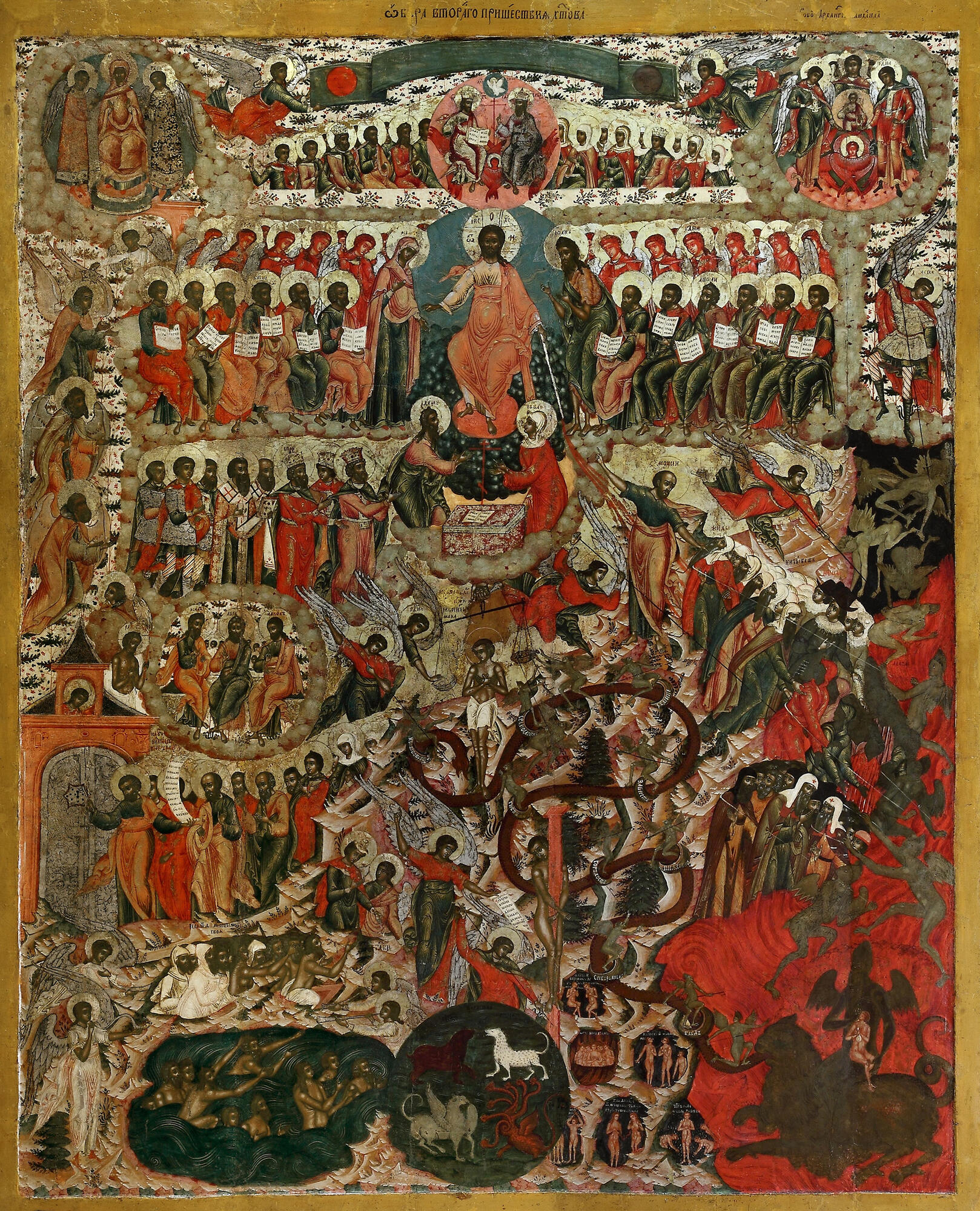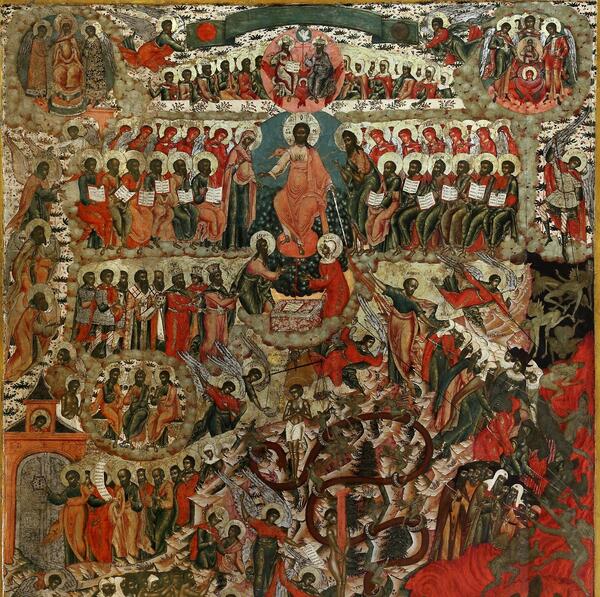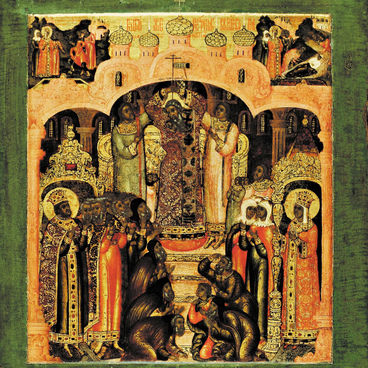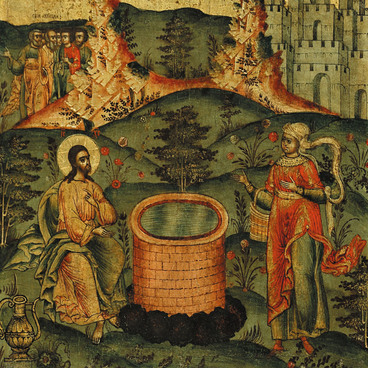The Judgment Day is described in detail in the Book of Enoch and the Book of Daniel. This is the first Apocalypse that was later included in the canonical texts of the Bible. It is mentioned in all the Gospels, particularly in the Gospel of Matthew, and in apocryphal literature written both in the time of the New Testament and earlier.
Before the Last Judgment, Christians will be persecuted, there will be a lot of heretical teachings, sin will prevail, and the world will be shaken with disasters, wars, and catastrophes until finally the dead will resurrect and Jesus will come with angels and saints.
Christ will be the Judge because “the Father judgeth no man, but hath committed all judgment unto the Son” (John 5:22), while the righteous will help him, “the saints shall judge the world” (1 Corinthians 6:2). Each human will be judged for their words, actions, and thoughts.
The eschatology of the image was detailed by Russian icon painters. The composition resembles the arch of the Gates of Paradise, with special emphasis on the symmetry of figures. The composition is rather complex.
The central line is formed by the figures of the Savior, the Altar and the Cross, the hand of God, and the soul being judged. Since the 16th century, the border between Paradise and Hell has been designated by the so-called “Gracious Fornicator” (standing next to a pillar) who is placed outside the punishments of Hell for his good deeds but also outside the joys of Paradise for committing adultery.
The dead rise out of earth and sea to face the Last Judgment.
Peter the Apostle leads the righteous people to the Gates of Paradise with keys in his hand. Among them is the Good Thief who had received a promise from Jesus while being on the cross, “Verily I say unto thee, Today shalt thou be with me in paradise” (Luke 40:43). Seated under the paradise trees are the souls of the righteous and the Old Testament Patriarchs: Abraham, Isaac, and Jacob.
Depicted to the left side of Christ (to the viewer’s right) is Hell. In the center of the abyss is the Devil seated on a fiery monster, with Judas Iscariot holding a bag with thirty pieces of silver. A serpent is depicted twisting up from the mouth of a monster; all along it are rings with the names of various sins. Evil spirits try to pull sinners of various nations to Hell. With one hand, Moses points to Christ, and with the other, he holds a sinner by his beard. Archangel Michael throws devils down into the abyss. This is also where non-Christians and unfaithful prelates, monks, and laymen are supposed to go. The animals at the bottom symbolize the Four Kingdoms of the Earth — Persia, Rome, Greece, and Macedonia.
The main idea of the Last Judgment is not to inspire fear but to celebrate justice and the victory of Light and Truth. This explains the triumphal character of the image.
Before the Last Judgment, Christians will be persecuted, there will be a lot of heretical teachings, sin will prevail, and the world will be shaken with disasters, wars, and catastrophes until finally the dead will resurrect and Jesus will come with angels and saints.
Christ will be the Judge because “the Father judgeth no man, but hath committed all judgment unto the Son” (John 5:22), while the righteous will help him, “the saints shall judge the world” (1 Corinthians 6:2). Each human will be judged for their words, actions, and thoughts.
The eschatology of the image was detailed by Russian icon painters. The composition resembles the arch of the Gates of Paradise, with special emphasis on the symmetry of figures. The composition is rather complex.
The central line is formed by the figures of the Savior, the Altar and the Cross, the hand of God, and the soul being judged. Since the 16th century, the border between Paradise and Hell has been designated by the so-called “Gracious Fornicator” (standing next to a pillar) who is placed outside the punishments of Hell for his good deeds but also outside the joys of Paradise for committing adultery.
The dead rise out of earth and sea to face the Last Judgment.
Peter the Apostle leads the righteous people to the Gates of Paradise with keys in his hand. Among them is the Good Thief who had received a promise from Jesus while being on the cross, “Verily I say unto thee, Today shalt thou be with me in paradise” (Luke 40:43). Seated under the paradise trees are the souls of the righteous and the Old Testament Patriarchs: Abraham, Isaac, and Jacob.
Depicted to the left side of Christ (to the viewer’s right) is Hell. In the center of the abyss is the Devil seated on a fiery monster, with Judas Iscariot holding a bag with thirty pieces of silver. A serpent is depicted twisting up from the mouth of a monster; all along it are rings with the names of various sins. Evil spirits try to pull sinners of various nations to Hell. With one hand, Moses points to Christ, and with the other, he holds a sinner by his beard. Archangel Michael throws devils down into the abyss. This is also where non-Christians and unfaithful prelates, monks, and laymen are supposed to go. The animals at the bottom symbolize the Four Kingdoms of the Earth — Persia, Rome, Greece, and Macedonia.
The main idea of the Last Judgment is not to inspire fear but to celebrate justice and the victory of Light and Truth. This explains the triumphal character of the image.



